Harbour Seals
Amazingly, there are limbs inside the fat-suit which seals wear. You would, however, be forgiven for thinking otherwise:
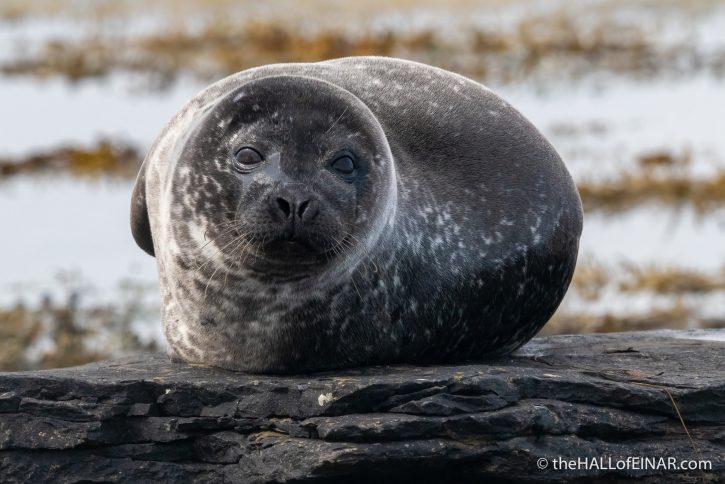
This one is delicately poised to wriggle and throw itself forwards. It looks like one of those spinning pieces which spins, rocks and then spins the other way; a rattleback.
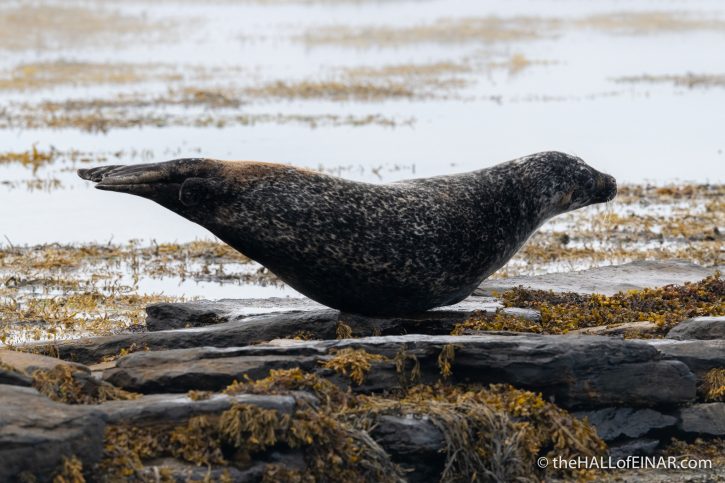
The Common Seal is featured in Reverend George Low’s Fauna Orcadensis from 1813:
SEAL Cutting teeth, and two canine teeth in each jaw; five palmated toes on each foot; body thick at the shoulders, tapering towards the tail.
I love the word palmated. It means ‘like a hand’.
The Common Seal
Seal, Seoile, or Sea-Calf. Orc. Selch, or Selchy.
Seals are called Selkies in Orkney. He continues:
SEALS with us are very numerous, especially in the desert isles, or sea rocks, that are separated from the land; here they lie, while the sea is low, in droves, and in season bring forth their young. Not having a specimen before me, I shall give that of my honoured friend Mr Pennant, as published in his works, to which, and his correspondence upon any difficulty, I have been often and much obliged, and think myself happy in having it in my power to return him, in this manner, my most grateful acknowledgments, for the countenance he has all along shewn me in the prosecution of this work, and ever since I had the honour to be known to him.
That’s possibly the longest attempt at saying ‘thank you’ I’ve ever read. He then starts the description:
The head and nose broad and flat, like those of the otter; the neck short and thick; the eyes large and black , tongue forked at the end; nostrils oblong: on each side the nose were several long stiff hairs (these in the specimens I have seen are undulated); and above each eye were a few of the same kind ; two canine teeth in each jaw; six cutting teeth in the upper jaw, four in the lower; no external ears; body covered with hair; short tail; toes furnished with strong and sharp claws; colour various, dusky, sand-coloured, brinded, spotted with white or yellow; the hair of the old ones is thick, short, and glossy; that of the young, long, white, and woolly.”
Who knew that Common Seals have forked tongues? Look how cute that little pink forked tongue is:
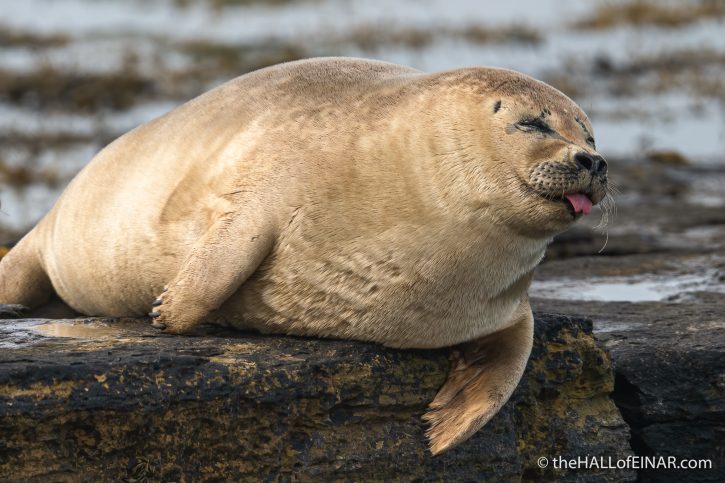
I’ve also never seen the word brinded before. It means having a grey or brown streak or a pattern or a patchy colouring. If it was a cat it would be called tabby. This one looks like a leopard to me:
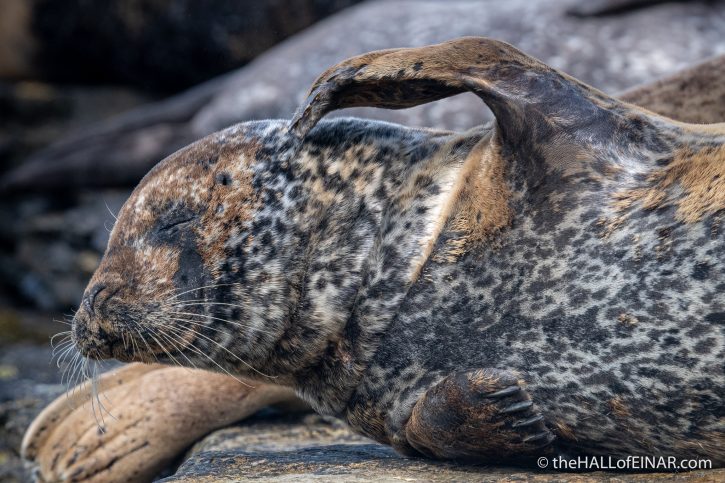
It’s definitely brinded.
The largest seal I ever saw in Orkney measured, from the point of the nose to the hinder claws, eight feet.
The seal swims with vast rapidity, and before a gale of wind is full of frolic, jumping and tumbling about sometimes wholly throwing itself above water, performing many awkward gambols, and at last retiring to its wonted rock, or cavern, which it keeps possession of (if undisturbed by man), from its own species (I have seen them often pushing one another down), and there continues till the storm is over.
This has got to be one of my favourite sentences in the entire book:
The seal swims with vast rapidity, and before a gale of wind is full of frolic, jumping and tumbling about sometimes wholly throwing itself above water, performing many awkward gambols, and at last retiring to its wonted rock, or cavern.
Seals seem to have a great deal of curiosity: if people are passing in boats, they often come quite close up to the boat, and stare at them, following for a long time together; if people are speaking loud, they seem to wonder what may be the matter. The church of Hoy, in Orkney, is situated near a small sandy bay, much frequented by these creatures; and I observed when the bell rung for divine service, all the seals within hearing swam directly for the shore, and kept looking about them, as if surprised, rather than frighted; and in this manner continued to wonder, as long as the bell rung.
Seals are very curious creatures. I’ve often been followed by them as I walk along the beach and they follow along, with eyes wide, shadowing your every move.
Numbers of seals are yearly caught about our coasts, both with nets and shot, for the sake chiefly of the skins and oil, though I am credibly informed, in North Ronaldsha they take them for another purpose, namely, for eating; and they say they make good ham. I have seen numbers of them cut up, and have no doubt but the young ones may eat tolerably well, but the large and old ones must be very ordinary feeding, because the flesh is both black and very coarse-grained.
I love the antiquated way of spelling North Ronaldsay.
A place I’ve always wanted to visit is Sule Skerry. It’s an island in the Atlantic Ocean, 60km off the coast of Mainland Orkney. It was a place regularly visited for an annual massacre of seals:
There is a ship commonly goes from this place once a-year to Soliskerry, and seldom returns without 200 or 300 seals. She is manned with between thirty and forty men, who, as soon as they come up with the rock, land (except a few left to keep the ship, and receive what the others kill), and immediately surround what seals are then on it. One party armed with clubs, fall to knocking them on the head, and another set to jacking, i. e. cutting off the skin, together with the blubber on it, while the others put it on board. They continue thus as long as they have any thing to do, and, when all is over, immediately set sail, otherwise they are in danger from the weather: if it blows up there is no such thing as getting into their boats. When they arrive the jacks are divided, and sold by public auction, at about five or six shillings sterling a piece; and each man makes about thirty shillings sterling for his share, after allowing a third for the vessel, and something more than a common share for the master. After all is disposed of, the blubber is cut from the skin, and boiled into oil, which sells well, and with profit to the merchant. The skins are pinned to the walls of houses till dry, and are then sold to the trunkmakers and others, for eightpence or one shilling a-piece, small and great.
I remember reading the ballad The Great Selkie of Sule Skerry long before I knew where Orkney was. There are many wonderful performances of it. Here’s the basic story: A woman is nursing a baby when a man appears and explains he’s the baby’s father. He’s a man on land and a selkie in the sea. He takes her baby in exchange for gold and says she’ll marry a gunner, the man who fires the harpoon on a whaling ship, and the gunner will kill both the man and her son. That’s a little fanciful and utterly doomed. Perfect for a traditional ballad.
Belief in shapeshifting may seem like ancient superstition but many people add animism to their other religeon. For instance, a large percentage of Chrtistians think Robins are the souls of dead relatives. It’s particularly memorable because of prophesying your own doom, but then the Scotland traditionally does prophecies of doom exceptionally well.
The Rev. continues in grisly fashion:
The young and smaller seals yield the most oil; the largest are good for little, except the skin; indeed, our seal-catchers seldom care for killing the old ones, where they can have the others.
Oh dear. It appears to have been more profitable to kill the fat babies than the older adults. Seals in the UK are protected by the 1970 Conservation of Seals Act, which prohibits most forms of killing, unless you want to skimp on the building of your Salmon farm and decide to shoot them to make your farmed Salmon business more profitable.
Our tanners dress the seal’s skin both for shoes and breeches, but they do not answer very well for the former, being soft and spongy; when properly managed do well for breeches. They are likewise dressed with the hair on, for saddle-covers, and I have seen very beautiful ones made into waistcoats.
Seals; good for trousers but not for shoes yet they do make beautiful waistcoats.
Seals seem to be subject to a plague, or murrain. About four years ago they drove ashore round our coasts in scores; likewise in Caithness many of them were found dead. They were observed to cough much, make a sort of plaintive noise, and when they died and drove ashore were much swelled, and appeared as if very fat, but when cut up were nothing but skin and bone.
This sounds very much like Phocine morbillivirus, formerly called Phocine Distemper Virus (PDV). It’s closely related to the distemper which dogs are vaccinated against. I wonder if anti-vaxxers get their pets vaccinated? It’s a horrible disease. It caused the deaths of more than 23,000 common seals in the North Sea in 1988 and 30,000 in 2002.
The places where seals abound most in Orkney are, the Skerries of Hoy, North Ronaldsha, and others of the north isles; the Barrel of Butter, Pightland Skerries, and several other holms of the south division of the islands; but they are to be found round all the flatter coasts, and the caverns of the sea.
The Barrel of Butter was formerly known as Carlin Skerry and is a skerry in Scapa Flow. Its name was changed to the annual rent paid to the laird who was the landlord for the right to kill seals on it, paid for by the people of Orphir; a barrel of butter.
I’ve seen seals recovered by fishers having drowned in their nets off the coast of Westray. It’s a tragic end for a wonderful animal. Here’s one having a snooze at Broughton on Westray. A rest on the rocks must help their digestion.
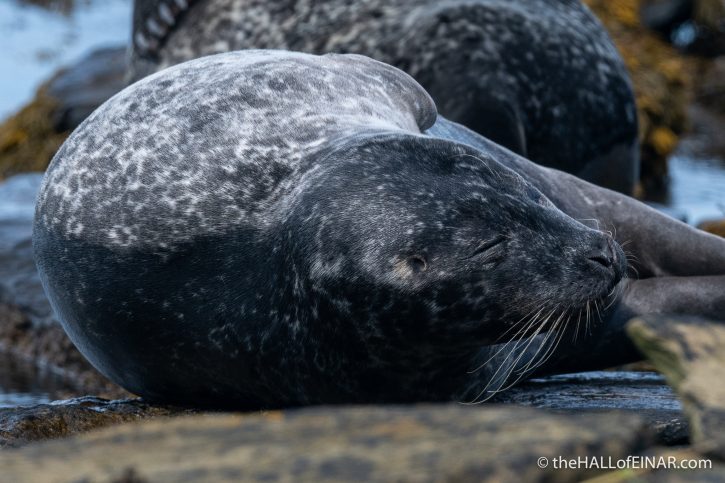
As it will mine.